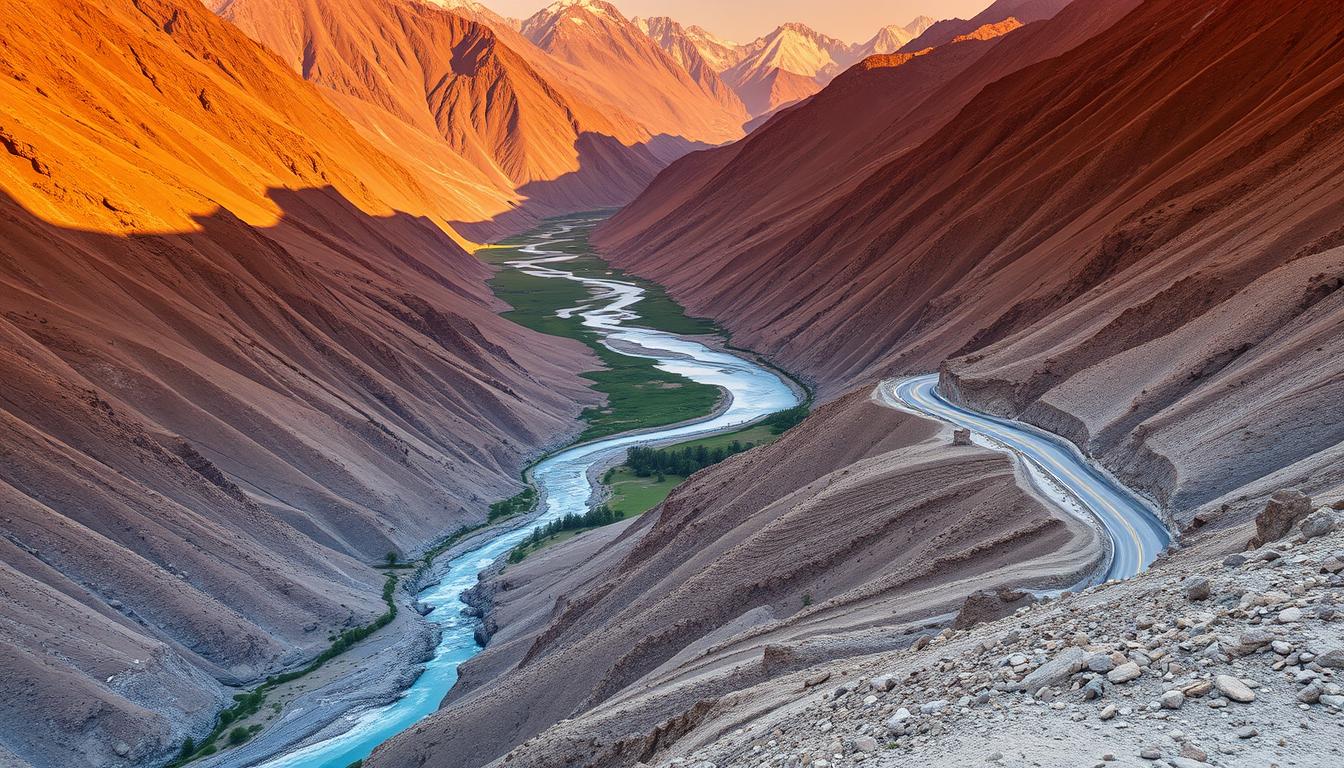Are you ready for an amazing journey through South Asia? Pakistan is full of contrasts, waiting for you. It has everything from the high Karakoram Mountains to the old Mohenjo-daro ruins. This country has adventures, cultural experiences, and architectural wonders that will leave you amazed.
Key Takeaways
- Explore the vibrant food scene and iconic landmarks of Lahore, the cultural heart of Pakistan.
- Witness the thrilling Shandur Polo Festival, one of the highest polo tournaments in the world.
- Discover the unique Kalash culture and traditions in the remote Chitral region.
- Traverse the daring hanging bridges of Gilgit-Baltistan for breathtaking Himalayan vistas.
- Unravel the mysteries of the Bronze Age civilization at the UNESCO World Heritage site of Mohenjo-daro.
So, are you ready for an unforgettable journey through Pakistan’s wonders? Get ready to be amazed by its rich culture, diverse landscapes, and friendly people. Let’s start exploring the best things to do in this incredible place!
Gorge Yourself on Lahore's Iconic Food Streets
Lahore is a paradise for food lovers. It’s known for its lively food scene, with over a dozen famous food streets. As night falls, the streets fill with the smells of spices and cooking meats.
Gawalmandi Food Street and Old Anarkali Food Street
Gawalmandi Food Street and Old Anarkali Food Street are top spots for food in Lahore. These places have many food stalls. Each one offers something special to eat.
Must-Try Dishes: Katlama, Grato Jalebi, and Spicy Kebabs
Don’t miss these must-try dishes in Lahore’s food scene:
- Katlama – A deep-fried bread with a tasty tomato and chili mix, served with lentils.
- Grato Jalebi – Sweet, cardamom-flavored treats that are fried right before your eyes.
- Spicy Kebabs – These kebabs are richly seasoned and grilled to perfection.
Let your senses lead you through Lahore’s food streets. Every bite is a new adventure in taste.
“The true delight of Lahore lies in the vibrant flavors that fill the air, tempting you to indulge in a culinary journey like no other.”
Experience the Thrilling Shandur Polo Festival
The Shandur Pass sits at an amazing 3,700 meters high. It’s like being at the top of the world. Every year, it hosts Pakistan’s most exciting polo tournament, the Shandur Polo Festival. Teams from Chitral and Gilgit-Baltistan come together, thrilling up to 40,000 fans with their amazing skills.
This festival is a cultural highlight, happening from the 7th to the 9th of July. It features six-player teams with reserves, playing matches for an hour with breaks. The final match wraps up the event on the 9th.
But it’s not just about the polo. The festival offers music, Pakistani food, and stunning views of the Hindukush mountains. You can also visit historical spots like the Chitral Valley and Chitral Town.
If you love polo or just want a unique cultural trip, don’t miss the Shandur Polo Festival. See the world’s highest polo action and enjoy the vibrant culture and stunning views. It’s an experience you won’t forget.
Discover the Kalash Culture in Chitral
In the heart of Pakistan’s Chitral district, the Kalash people keep their unique culture alive for centuries. They are known for their animistic beliefs, their own language, and their colorful traditional clothes. Visitors get to see a world that is truly special.
Immerse in Kalash Traditions and Festivals
Visiting during their festivals is the best way to experience the Kalash culture. The Chawmos festival, held during the Winter Solstice, is a big event. You’ll see the Kalash people in their traditional clothes, enjoy their music and dance, and learn about their beliefs.
Kalasha women wear long robes with cowrie shells and caps called kupas. The Kalash Valley, with its three valleys and the Hindu Kush mountains, is a place to dive deep into their ancient traditions.
The tour of the Kalash Valley is not too hard, but it’s best from April to October. Winters are cold with lots of snow.
“The Kalash people’s connection to their land and traditions is truly awe-inspiring. Witnessing their festivals and experiencing their way of life is a humbling and unforgettable experience.”
Looking to explore an ancient culture or the stunning nature of Northern Pakistan? A trip to the Kalash Valley is a must for adventurous travelers.
Cross the Daring Hanging Bridges of Gilgit-Baltistan
If you’re looking for an adrenaline rush in Pakistan, the hanging bridges of Gilgit-Baltistan are perfect. These bridges hang over rushing rivers, offering a thrilling experience. They are made of wooden slats and rope.
The Hussaini Hanging Bridge is a famous one. It connects the Hussaini Valley with Zuraabad and is 635 feet long. Built in 1964, it has gaps between the planks and sways in the wind. Crossing it gives you amazing views of the Hunza Valley, known as the original Shangri La.
For a bigger challenge, try the Passu Suspension Bridge. It’s 900 feet long with a narrow gap between the steps. It links Passu and Khuramabad, showing off Gilgit-Baltistan’s rugged beauty.
“Crossing these hanging bridges is a rite of passage for the adventurous traveler in Pakistan. The views are worth the white-knuckle experience.”
Gilgit-Baltistan is full of natural wonders beyond the bridges. You’ll find the 8th highest mountain, Nanga Parbat, and the beautiful Ghizer Valley with its lakes and glaciers. If you’re brave enough, come and cross the daring hanging bridges of Gilgit-Baltistan.
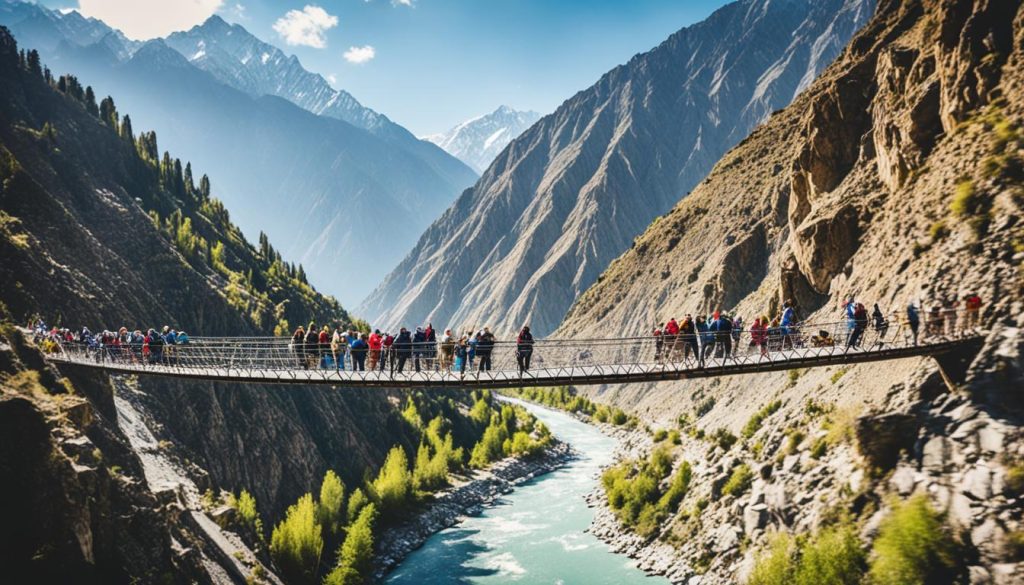
Pakistan: Best Things to Do - Top Picks
Get ready for an amazing trip through Pakistan, a place full of ancient history, vibrant culture, and stunning nature. You’ll see the famous Badshahi Mosque in Lahore and trek in the Hunza Valley. This guide will show you the best things to do and see in this amazing country.
Start your trip in Lahore, a city full of life. You can try delicious foods like katlama, grato jalebi, and spicy kebabs at the Gawalmandi Food Street and Old Anarkali Food Street.
Head north to see the Shandur Polo Festival, a long-standing tradition. Then, go to the Karakoram Mountains and visit the Hunza Valley. It’s perfect for trekkers with its beautiful views and rich culture.
Meet the Kalash people in the Chitral region and learn about their unique traditions. Try the daring hanging bridges of Gilgit-Baltistan for an exciting experience in a beautiful setting.
Visit the Mohenjo-daro ruins, a UNESCO World Heritage Site that takes you back to ancient times. See the rock-cut Buddha in Swat, showing Pakistan’s artistic talent.
Feel the spiritual side of Pakistan by visiting the Sufi shrines in Multan. Don’t miss the qawwali music, a tradition that has wowed people for years.
End your trip by seeing the Badshahi Mosque at sunset. It’s a sight you won’t forget. Then, visit the Lok Virsa Museum to learn about Pakistan’s art and traditions.
As you travel through Pakistan, you’ll be amazed by the friendly people, deep history, and beautiful landscapes. Get ready to make memories and find the hidden treasures of this incredible country.
| Top Attractions | Location |
|---|---|
| Badshahi Mosque | Lahore |
| Shandur Polo Festival | Shandur Pass |
| Hunza Valley | Gilgit-Baltistan |
| Kalash Valleys | Chitral |
| Mohenjo-daro Ruins | Sindh |
| Sufi Shrines, Multan | Multan |
Pakistan has adventures, cultural experiences, and stunning nature. It’s ready for you to explore. Get ready for an amazing journey through this captivating country.
Unravel Moenjodaro's Bronze Age Civilization
Moenjodaro is in the Indus Valley and shows us one of the world’s first cities. It was found in the 1920s and is now a UNESCO World Heritage Site. It gives us a peek into the Indus Valley Civilization’s advanced life in the Bronze Age.
Planned City Layout and Ancient Architecture
The Indus Valley Civilization was known for its great city planning. Moenjodaro is a perfect example. It had streets with buildings, a big citadel, guard towers, and over 700 wells and baths. This shows how they knew how to make cities work well.
The buildings in Moenjodaro were amazing. They used baked bricks and had cool designs. They even used waterproof mortar. The city had a great drainage system, which was very smart for its time.
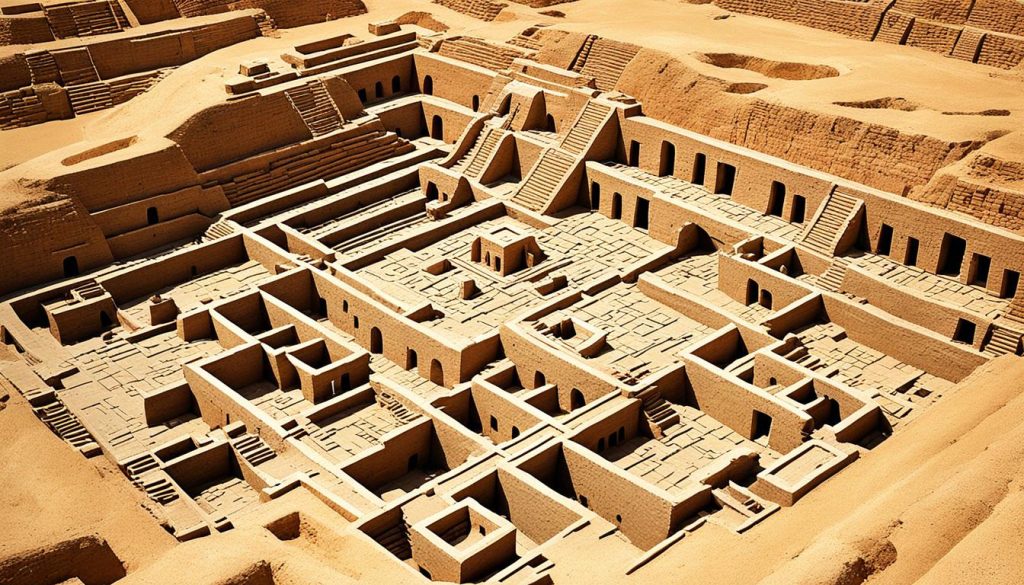
Artifacts found there show the people’s skill in making things. There were statues, bronze and silver bowls, and toys. These items tell us about their culture and economy. They lived in a well-planned city.
“The discovery of Harappa reveals that the Indus Valley civilization dates back over 4,500 years ago, making it one of the oldest civilizations in the world.”
Moenjodaro’s city plan and ancient buildings give us a look into a sophisticated Bronze Age society. This site amazes scholars and visitors. It shows us one of the earliest and most advanced cities in history.
Marvel at the Rock-Cut Buddha of Swat
In the beautiful Swat Valley of Pakistan, you’ll find a stunning piece of Buddhist history – the Rock-Cut Buddha. This valley was once full of temples, stupas, and amazing rock carvings. It was a place where Buddhism thrived before Islam came.
The 7th-century Buddha statue is carved right into the cliff. It shows the skill and faith of the people who lived there. The big statue sits in the lotus position, looking out over the valley. It symbolizes the peace and spirituality of the past.
But the statue faced a tough time when the Taliban attacked it in 2007. Thankfully, it was carefully fixed and is now a special place for visitors. The Rock-Cut Buddha of Swat still amazes people today. It shows the beauty of Buddhism in Pakistan and the lasting culture of the Swat Valley.
“The Rock-Cut Buddha of Swat stands as a testament to the region’s enduring cultural heritage, a silent witness to the ebb and flow of civilizations that have shaped the history of this remarkable land.”
When you visit the Swat Valley, don’t miss this incredible site. It’s where history and today meet in a stunning way. The Rock-Cut Buddha of Swat is a key spot that will deeply move anyone looking to discover Pakistan’s hidden treasures.
Embrace Sufism in the City of Saints, Multan
Multan is known as the “City of Saints” and is a place full of Sufism’s deep history. It has a history of over 5,000 years. The city is filled with Sufi shrines and the beautiful sounds of qawwali music.
Experience Qawwali Music at Sufi Shrines
Visiting Multan means experiencing the spiritual vibe of its Sufi shrines. These places are dedicated to famous Sufi saints and draw pilgrims from all over. As you explore, the beautiful sounds of qawwali music will touch your heart.
The Urs Festival is a big event that honors Sufi saints. It brings over 100,000 people to the Tomb of Shah Rukne Alam. This tomb is known for its stunning red brick design and is a key site in southern Punjab.
The Tomb of Bahauddin Zakariya is another must-see, built in the 13th century. It shows the area’s deep Sufi roots. The Shrine of Shah Yusuf Gardezi is famous for its amazing blue tiles and Ayina Kari decoration.
At these Sufi shrines, you feel like you’re in a place where the world and the spiritual meet. It leaves you feeling deeply connected and amazed.
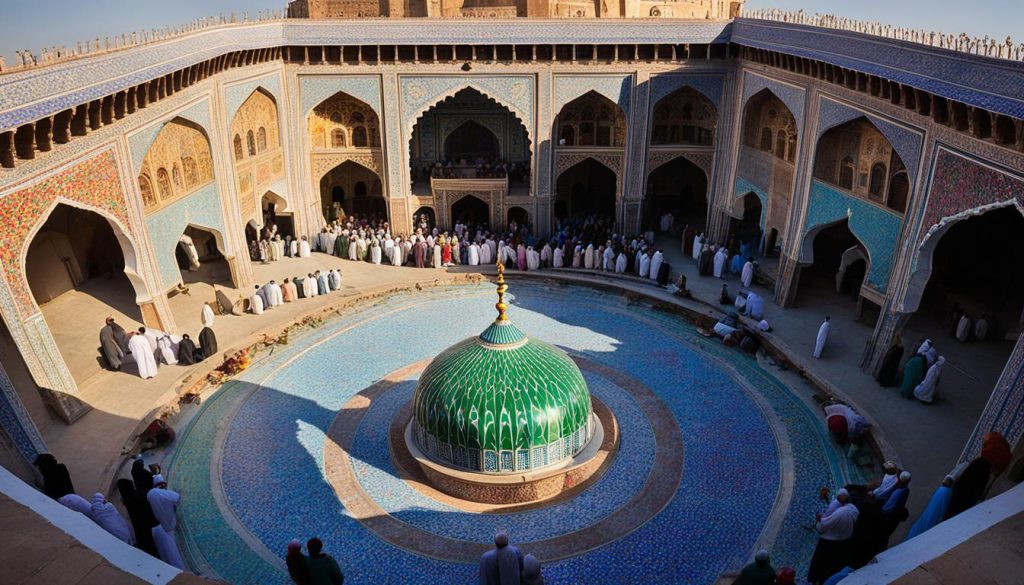
“Sufism in Pakistan is embraced by large segments of the underclass, emphasizing equality and tolerance.”
Sufism has deeply influenced Multan, shaping its architecture and culture. It has also impacted Pakistani poetry, music, and dance. The rhythms and melodies of qawwali music take you to a place where the spiritual and physical blend perfectly.
Witness the Badshahi Mosque's Splendor at Sunset
In the heart of Lahore, the Badshahi Mosque is a stunning example of Indo-Islamic architecture. It has amazed visitors for centuries. At sunset, it becomes even more breathtaking, inviting everyone to see its beauty.
The Mughal Emperor Aurangzeb built it in the 17th century. It’s one of South Asia’s biggest mosques, holding up to 100,000 people. Its pink sandstone walls and white marble domes look amazing, especially in the golden evening light.
Visit during the last two hours before it closes, usually around 8 PM. The mosque’s beauty is magical as shadows grow and the call to prayer fills the air. It feels like stepping back into the Mughal Empire’s glory days.
If you love history, architecture, or just amazing sights, don’t miss the Badshahi Mosque in Lahore. Watching the sunset here is unforgettable. This place is a gem in Pakistan’s cultural treasures.
Immerse in Cultural Heritage at Lok Virsa Museum
In the heart of Islamabad, the Lok Virsa Museum is a key spot for exploring Pakistan’s rich culture. It’s the biggest museum in the country, filled with traditions, craftsmanship, and diversity. This place shows what makes Pakistani culture special.
At the Lok Virsa Museum, you get to see sculpture, textiles, jewelry, and woodwork up close. These items show the skills and art passed down through generations. You can also listen to audio and video recordings to learn more about Pakistan’s many ethnic groups.
The museum is dedicated to keeping Pakistan’s cultural heritage alive. It has everything from Balochi embroidery to Sindhi folk music. This makes it a great place to explore Pakistan’s diverse culture.
If you love culture or are just curious, the Lok Virsa Museum in Islamabad is a must-visit. It will deepen your understanding and appreciation of Pakistani culture. Dive into the traditions and stories that make this country unique.
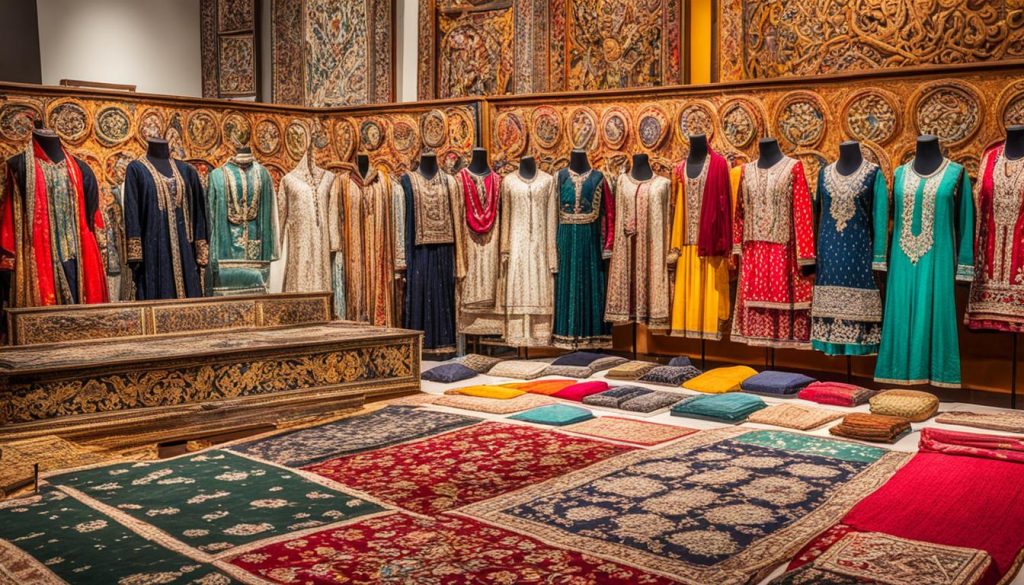
| Key Facts about Lok Virsa Museum | Details |
|---|---|
| Location | Islamabad, Pakistan |
| Size | Covers an area of 20,000 square feet |
| Purpose | Showcases the history and living traditions of various ethnic groups from across Pakistan |
| Highlights |
|
Conclusion
This guide has shown you the best things to do in Pakistan. It’s a place full of culture, natural beauty, and adventure. You’ve seen the ancient ruins of Mohenjo Daro, a UNESCO site over 4,500 years old. And you’ve learned about the Sufi traditions in Multan, the “City of Saints.”
Looking for tasty street food in Lahore or the beauty of the Badshahi Mosque at sunset? Or maybe you want to try the daring hanging bridges of Gilgit-Baltistan. This guide has the top picks for your perfect trip to Pakistan. With its mix of cultures and stunning landscapes, Pakistan will leave a mark on you.
As you start your trip, let this guide be your friend. It has all the info, tips, and experiences for an amazing journey. Whether you’re alone or with family, Pakistan has something for everyone. Dive into its traditions, taste its food, and make memories in its stunning nature.
